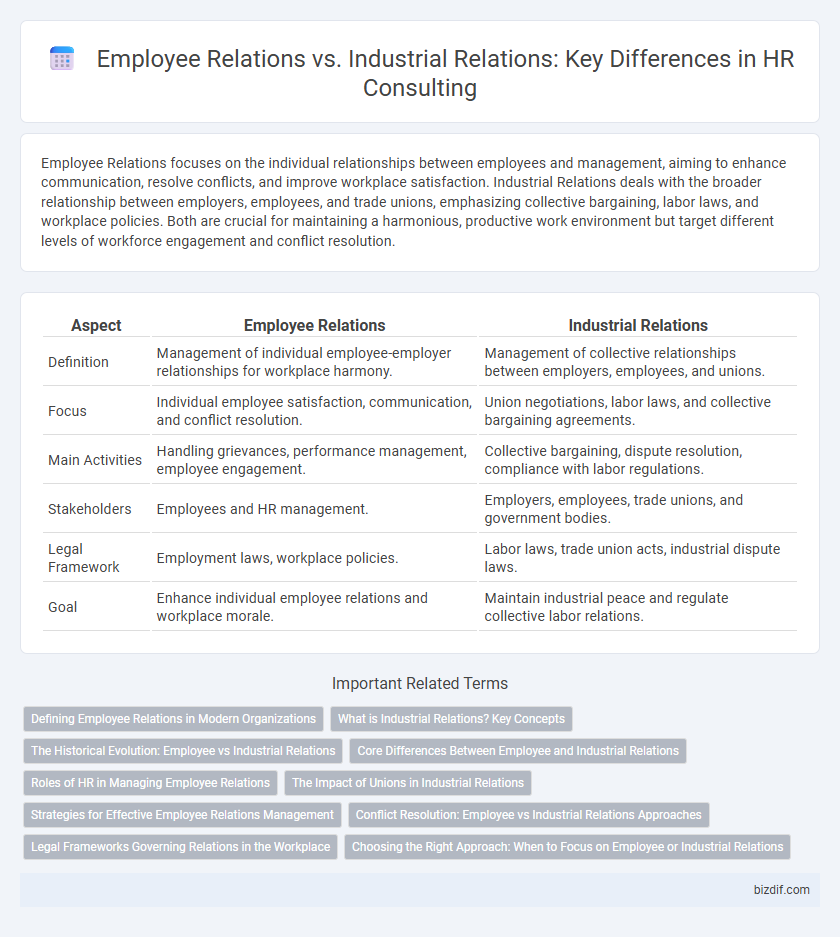Employee Relations focuses on the individual relationships between employees and management, aiming to enhance communication, resolve conflicts, and improve workplace satisfaction. Industrial Relations deals with the broader relationship between employers, employees, and trade unions, emphasizing collective bargaining, labor laws, and workplace policies. Both are crucial for maintaining a harmonious, productive work environment but target different levels of workforce engagement and conflict resolution.
Table of Comparison
| Aspect | Employee Relations | Industrial Relations |
|---|---|---|
| Definition | Management of individual employee-employer relationships for workplace harmony. | Management of collective relationships between employers, employees, and unions. |
| Focus | Individual employee satisfaction, communication, and conflict resolution. | Union negotiations, labor laws, and collective bargaining agreements. |
| Main Activities | Handling grievances, performance management, employee engagement. | Collective bargaining, dispute resolution, compliance with labor regulations. |
| Stakeholders | Employees and HR management. | Employers, employees, trade unions, and government bodies. |
| Legal Framework | Employment laws, workplace policies. | Labor laws, trade union acts, industrial dispute laws. |
| Goal | Enhance individual employee relations and workplace morale. | Maintain industrial peace and regulate collective labor relations. |
Defining Employee Relations in Modern Organizations
Employee relations in modern organizations focus on fostering positive interpersonal relationships between employees and management to enhance workplace morale, productivity, and communication. It involves addressing employee concerns, promoting engagement, and ensuring compliance with labor laws and organizational policies. Effective employee relations contribute to a collaborative work environment and reduce conflicts, distinct from industrial relations which primarily manage union interactions and collective bargaining processes.
What is Industrial Relations? Key Concepts
Industrial Relations refers to the management and regulation of relationships between employers, employees, and their unions within the workplace. Key concepts include collective bargaining, labor disputes, workers' rights, and the role of trade unions in negotiating employment terms. Effective industrial relations aim to maintain harmonious employer-employee interactions and ensure legal compliance in work environments.
The Historical Evolution: Employee vs Industrial Relations
The historical evolution of employee relations traces the shift from individualized employer-employee interactions to a broader focus on workplace culture and employee engagement, emphasizing direct communication and conflict resolution. Industrial relations emerged during the Industrial Revolution, centered on collective bargaining, labor unions, and regulatory frameworks addressing workers' rights and employer responsibilities in large-scale industries. Understanding this evolution highlights the transition from adversarial labor-management dynamics to more collaborative and integrative approaches in modern HR consulting.
Core Differences Between Employee and Industrial Relations
Employee relations centers on fostering direct communication and positive interactions between management and individual employees to enhance workplace satisfaction and performance. Industrial relations involve managing collective relationships, primarily between management, labor unions, and employee groups, to negotiate wages, working conditions, and dispute resolutions. The core difference lies in employee relations focusing on individual employee engagement, while industrial relations emphasize collective bargaining and union-management dynamics.
Roles of HR in Managing Employee Relations
Human Resources plays a critical role in managing employee relations by fostering open communication, resolving workplace conflicts, and ensuring compliance with organizational policies to maintain a positive work environment. Unlike industrial relations, which primarily involve negotiations and interactions between employers and labor unions, employee relations focus on individual employee engagement, satisfaction, and performance management. Effective HR practices in employee relations contribute to improved employee morale, reduced turnover, and enhanced organizational productivity.
The Impact of Unions in Industrial Relations
Unions play a critical role in industrial relations by representing collective employee interests, negotiating labor contracts, and influencing workplace policies. Their impact often leads to structured dispute resolution mechanisms, improved working conditions, and balanced power dynamics between employers and employees. Effective union engagement in industrial relations fosters organizational stability and compliance with labor laws, distinguishing it from the more individualized focus of employee relations.
Strategies for Effective Employee Relations Management
Effective employee relations management centers on transparent communication channels, conflict resolution mechanisms, and fostering trust between employees and management. Strategies include implementing regular feedback systems, promoting inclusive workplace culture, and training managers in emotional intelligence to anticipate and address workforce concerns proactively. These approaches enhance employee engagement, reduce grievances, and align workforce objectives with organizational goals, distinguishing employee relations from the broader scope of industrial relations.
Conflict Resolution: Employee vs Industrial Relations Approaches
Employee relations focus on resolving workplace conflicts through direct communication, mediation, and fostering positive employer-employee relationships to improve job satisfaction and productivity. Industrial relations emphasize collective dispute resolution involving unions and management negotiations, often utilizing formal grievance procedures, collective bargaining, and labor law frameworks. Conflict resolution in employee relations is typically individualized and informal, whereas industrial relations involve structured, legalistic approaches addressing group-based workplace issues.
Legal Frameworks Governing Relations in the Workplace
Employee relations primarily involve managing the day-to-day interactions between employers and employees under labor laws such as the Fair Labor Standards Act (FLSA) and the Occupational Safety and Health Act (OSHA). Industrial relations focus on the broader legal frameworks governing collective bargaining, union activities, and dispute resolution regulated by laws like the National Labor Relations Act (NLRA) and the Labor Management Relations Act (LMRA). Understanding these legal frameworks is crucial for HR consultants to ensure compliance, prevent workplace conflicts, and maintain effective labor-management relations.
Choosing the Right Approach: When to Focus on Employee or Industrial Relations
Effective HR consulting requires distinguishing between employee relations and industrial relations based on organizational needs and workforce dynamics. Employee relations emphasizes individual and group interactions, focusing on communication, conflict resolution, and job satisfaction to boost employee morale and productivity. Industrial relations centers on the collective relationship between management and labor unions, addressing collective bargaining, labor laws, and dispute resolution to maintain workforce stability and regulatory compliance.
Employee Relations vs Industrial Relations Infographic

 bizdif.com
bizdif.com